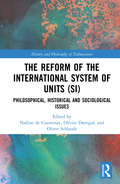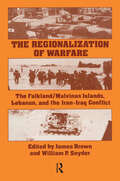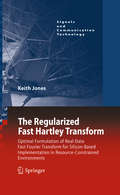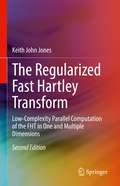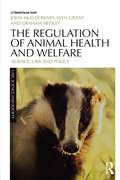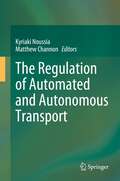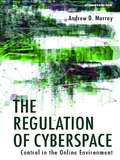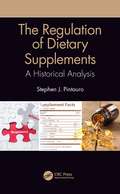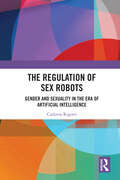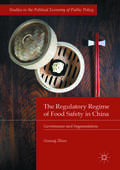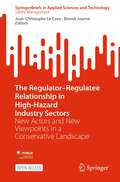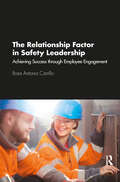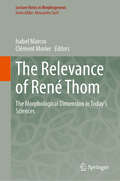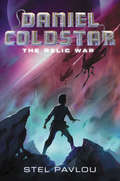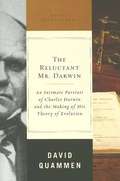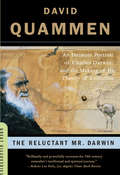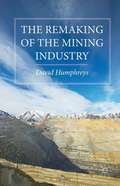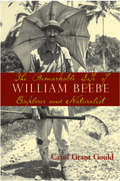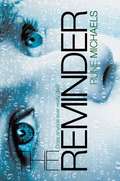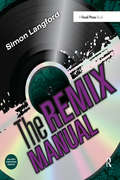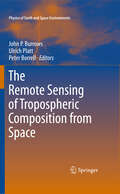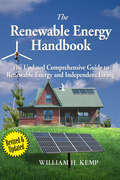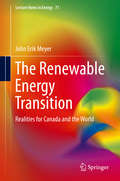- Table View
- List View
The Reform of the International System of Units: Philosophical, Historical and Sociological Issues (History and Philosophy of Technoscience)
by Olivier Darrigol Oliver Schlaudt Nadine CourtenaySystems of units still fail to attract the philosophical attention they deserve, but this could change with the current reform of the International System of Units (SI). Most of the SI base units will henceforth be based on certain laws of nature and a choice of fundamental constants whose values will be frozen. The theoretical, experimental and institutional work required to implement the reform highlights the entanglement of scientific, technological and social features in scientific enterprise, while it also invites a philosophical inquiry that promises to overcome the tensions that have long obstructed science studies.
The Regionalization of Warfare: The Falkland/Malvinas Islands, Lebanon, and the Iran-Iraq Conflict
by James Brown William P. SnyderThree wars have dominated world events in recent years: The conflict which erupted between the United Kingdom and Argentina over the Falkland/Malvinas Islands; the multinational conflict in Lebanon involving Irsaeli, Syrian, and FLO forces in Lebanon; and the savage struggles between ground and air units of the Iranian and Iraqi forces. The scale and intensity of these wars, their potential for global conflict, make them crucial for an understanding among citizens in general, and defense and political analysts in particular.The authors and contributors to this most unusual volume come to several common conclusions: professionalism is a crucial factor in military effectiveness, but not necessarily dependent on modes of recruitment; high technology is crucial, but only in relation to the quality and training of the personnel; public support is necessary to sustain military morale in democratic and authoritarian regimes alike. These are only some of the incisive findings registered and explored in The Regionalization of Warfare.The volume a'ssembles experts not only on these three major regional and interregional conflicts, but on current U.S. defense policies; Soviet strategic interests in Middle East and Persian Gulf conflicts; and a series of papers on lessons learned and unlearned as a result of these "small wars" of the early 1980s. For those interested in military history, global strategy, and regional rivalries, this -collection of finely written, sophisticated papers will prove to be of intense concern.
The Regularized Fast Hartley Transform
by Keith JonesThe Regularized Fast Hartley Transform provides the reader with the tools necessary to both understand the proposed new formulation and to implement simple design variations that offer clear implementational advantages, both practical and theoretical, over more conventional complex-data solutions to the problem. The highly-parallel formulation described is shown to lead to scalable and device-independent solutions to the latency-constrained version of the problem which are able to optimize the use of the available silicon resources, and thus to maximize the achievable computational density, thereby making the solution a genuine advance in the design and implementation of high-performance parallel FFT algorithms.
The Regularized Fast Hartley Transform: Low-Complexity Parallel Computation of the FHT in One and Multiple Dimensions
by Keith John JonesThis book describes how a key signal/image processing algorithm – that of the fast Hartley transform (FHT) or, via a simple conversion routine between their outputs, of the real‑data version of the ubiquitous fast Fourier transform (FFT) – might best be formulated to facilitate computationally-efficient solutions. The author discusses this for both 1-D (such as required, for example, for the spectrum analysis of audio signals) and m‑D (such as required, for example, for the compression of noisy 2-D images or the watermarking of 3-D video signals) cases, but requiring few computing resources (i.e. low arithmetic/memory/power requirements, etc.). This is particularly relevant for those application areas, such as mobile communications, where the available silicon resources (as well as the battery-life) are expected to be limited. The aim of this monograph, where silicon‑based computing technology and a resource‑constrained environment is assumed and the data is real-valued in nature, has thus been to seek solutions that best match the actual problem needing to be solved.
The Regulation of Animal Health and Welfare: Science, Law and Policy (Law, Science and Society)
by Wyn Grant John McEldowney Graham MedleyThe Regulation of Animal Health and Welfare draws on the research of scientists, lawyers, economists and political scientists to address the current and future regulatory problems posed by the issues of animal health and disease. Recent events such as the outbreak of mad cow disease, epidemics of foot and mouth disease, concerns about bluetongue in sheep, and the entry into the food chain of the offspring of cloned cattle, have heightened awareness of the issues of regulation in animal disease and welfare. This book critically appraises the existing regulatory institutions and guiding principles of how best to maintain animal health in the context of social change and a developing global economy. Addressing considerations of sound science, the role of risk management, and the allocation of responsibilities, it also takes up the theoretical and practical challenges which here – and elsewhere – attend the co-operation of scientists, social scientists, lawyers and policy makers. Indeed, the collaboration of scientists and social scientists in determined and regulatory contexts such as that of animal disease is an issue of ever-increasing importance. This book will be of considerable value to those with interests in this issue, as well as those concerned with the law and policy relating to animal health and welfare.
The Regulation of Automated and Autonomous Transport
by Kyriaki Noussia Matthew ChannonThis book discusses various legal aspects of automated and autonomous transport. The regulation of automated and autonomous transport encompasses legislation on automated cars, ships, vessels, and drones. Questions surrounding this novel area of the law, which has attracted major worldwide interest and publicity, are likely to dominate our societies and everyday life in the years ahead. One major challenge addressed in this book is remedying the regulatory fragmentation that can be observed around the globe concerning legislation on automated and autonomous transportation systems. Written and edited by respected experts in the field, including academics and practitioners alike, this book seeks to fill an important gap in the literature.Given its focus and scope, the book will be of considerable interest to practitioners, academics, and policymakers, judges, students and secondary audiences, including engineers, sociologists, naval architects, all those involved in the automated industry, and people working in AI.
The Regulation of Cyberspace: Control in the Online Environment
by Andrew MurrayExamining the development and design of regulatory structures in the online environment, The Regulation of Cyberspace considers current practices and suggests a regulatory model that acknowledges its complexity and how it can be used by regulators to provide a more comprehensive regulatory structure for cyberspace. Drawing on the work of cyber-regulatory theorists, such as Yochai Benkler, Andrew Shapiro and Lawrence Lessig, Murray explores and analyzes how all forms of control, including design and market controls, as well as traditional command and control regulation, are applied within the complex and flexible environment of cyberspace. It includes chapters on: the role of the cyberlawyer environmental design and control online communities cyber laws and cyber law-making. This book is an essential read for anyone interested in law and information technology.
The Regulation of Dietary Supplements: A Historical Analysis
by Stephen J. PintauroThis book documents the long, still ongoing battle between the US Food and Drug Administration and the dietary supplement industry. It presents the complex, often subtle, and sometimes overlooked series of events that had a major impact on how dietary supplements are manufactured, marketed, sold, and used today. While the first few chapters focus on some background topics, the remaining chapters walk the reader through timeline of events, legislative actions, FDA proposed and final rules, and judicial decisions that led to our current dietary supplement regulatory framework. Interwoven in narrative are examples of the roles of science, social and public policy, politics, and popular media.
The Regulation of Sex Robots: Gender and Sexuality in the Era of Artificial Intelligence
by Carlotta RigottiThis book proposes a framework for regulating sex robots – human-like machines designed to engage emotionally and sexually with users through customisable, often AI-powered features.Although they occupy a niche in the adult entertainment and technology industries, sex robots raise complex issues that extend beyond current debates. To date, sex robots are frequently portrayed either as tools for societal liberalisation and remedies for sexual inequalities or as mediums for sexual commodification and personal degradation. These conflicting perspectives echo longstanding feminist debates, which often lead to polarisation and normative deadlock, overlooking the lived experiences of individuals beyond binary and heteronormative frameworks. The evolving legal landscape further complicates these issues. Regulatory bodies, such as the European Union, struggle to keep pace with emerging technologies and human-machine interactions. Their tendency to evaluate innovations as products with hypothetical risks – through a detached, top-down approach – fails to address the intersectional dynamics of privilege and oppression. This book enriches the conversation by moving beyond binary narratives of emancipation and oppression. It challenges the socio-legal construction of gender and sexuality, critiques regulatory inertia and morality policing, and advocates for nuanced, context-aware regulation of sex robots.It will appeal to researchers in socio-legal studies, law and technology, gender and law, as well as those in sociology and gender studies, offering critical insights into the regulation of gendered and sexualised technologies and their broader societal implications.
The Regulatory Landscape in the EU for Dairy Products Derived from Precision Fermentation: An Analysis on the Example of Cheese (SpringerBriefs in Law)
by Kai P. Purnhagen Federica Ronchetti Laura SpringerThis book assesses the EU legal framework applicable to dairy products obtained through precision fermentation. It maps the authorisation and labelling requirements for these products to be placed on the EU market. It compares these provisions to those governing the food markets in the USA and Singapore, which are considered to be more innovation-friendly. At the time of writing, the precision-fermented dairy sector is still in the developmental phase, with only a few precision-fermented dairy alternatives available on the market, none of which are present in the EU. Regulatory uncertainty has been cited as significant obstacle for food business operators seeking to introduce alternative protein products in the EU. The book confirms these reports, as the current EU regulatory framework presents several legal uncertainties that are challenging for food business operators to overcome. Broadly speaking, there are two authorisation frameworks applicable to dairy products obtained through precision fermentation in the EU. The choice between these frameworks depends on the presence of genetically modified organisms (GMOs) or residues thereof in the final product. If such GMOs or residues are present, the pre-market authorisation procedure is governed by the Genetically Modified Food and Feed Regulation (GMFR). If the final product does not contain any GMOs or residues, it falls under the scope of the Novel Food Regulation (NFR), and the pre-market authorisation procedure is governed accordingly. Both of these authorisation pathways entail high regulatory requirements, which can pose challenges for the development of the precision fermentation sector. Despite the difficulty in accurately classifying products, it is crucial for food business operators to comprehend the applicable legal framework early in the product development process, given that the authorisation paths differ in their standards. In addition to pre-market authorisation requirements, companies must address labelling issues. Food labelling shall provide a basis for consumers to make informed choices in relation to the foods they consume. The primary objective of EU food labelling law is to prevent consumer deception , making it crucial for dairy products and their animal-free alternatives, to adhere to a stringent naming law as stipulated in the Common Market Organisation and specific accompanying legislation. Moreover, it is imperative to consider regulations regarding the use of health and nutrition claims, as well as labels such as “vegan” or “organic”, etc. Furthermore, the labelling of novel foods and genetically modified foods may necessitate mandatory information specified in the authorisation process. The book serves as a comprehensive guideline for food business operators involved in the production of precision-fermented dairy alternatives, aiding them in navigating the intricate European regulatory landscape.
The Regulatory Regime of Food Safety in China
by Guanqi ZhouThis book examines the decade from 2004 to 2013 during which people in China witnessed both a skyrocketing number of food safety crises, and aggregating regulatory initiatives attempting to control these crises. Multiple cycles of "crisis - regulatory efforts" indicated the systemic failure of this food safety regime. The book explains this failure in the "social foundations" for the regulatory governance of food safety. It locates the proximate causes in the regulatory segmentation, which is supported by the differential impacts of the food regulatory regime on various consumer groups. The approach of regulatory segmentation does not only explain the failure of the food safety regime by digging out its social foundation, but is also crucial to the understanding of the regulatory state in China.
The Regulator–Regulatee Relationship in High-Hazard Industry Sectors: New Actors and New Viewpoints in a Conservative Landscape (SpringerBriefs in Applied Sciences and Technology)
by Benoît Journé Jean-Christophe Le CozeThis open access book addresses relationships that develop from the complex set of legislative, regulatory, and institutional arrangements that arise in the governance of high-hazard industries, especially those connected with safety. It analyses the difference in practices between high-hazard sectors such as nuclear power, chemical processing, and transport with those in the finance and healthcare sectors. The relationship between regulating and regulated entities is important in ensuring that safety is not subordinated to other concerns and in maintaining public confidence. As a result, the brief addresses various pressures and trade-offs inherent in that relationship, trade-offs between such considerations as: cost of the oversight activity and its effectiveness; regulator independence and its level of competency and understanding of the risks involved; ability to provide advice on meeting regulatory goals and being able to criticize decisions made; and effectiveness and intrusion in operational activities. The contributors show how, over time, a more horizontal or “decentred” approach to regulatory oversight has appeared, with a larger degree of delegation of certain decisions to industry and a greater role for a range of third parties such as certification bodies, auditors, insurers, industry associations and NGOs. This book is of interest to academics working in the fields of safety science or organizational management and to practitioners, regulators and policy-makers concerned with health and safety and critical infrastructure.
The Relationship Factor in Safety Leadership: Achieving Success through Employee Engagement
by Rosa Antonia CarrilloAt the core of The Relationship Factor in Safety Leadership are eight beliefs about human nature that are common to leaders who successfully communicate that safety is important while meeting business results. Using stories and business language the book explains how to create and recover important stakeholder relationships by setting priorities and taking action based on these beliefs. The beliefs are based on the author’s 25 years of experience supporting operational and safety leaders with successful and unsuccessful change efforts in pharmaceutical, nuclear, mining, manufacturing and power generation. The author also offers compelling evidence from many social and scientific disciplines that support the conclusion that satisfying our need for relationship is a major motivator. The Five Orientations Model offers a perspective on solving complex problems when confronted with multiple demands. The book provides managers and supervisors with the motivation to build relationships and points to the conditions needed for success. It also describes a process to take united action but retain the flexibility to change course as necessary. The book is written for managers and leaders, at all levels, concerned with occupational health and safety, and wishing to learn how to leverage relationships to achieve higher employee engagement and performance.
The Relevance of René Thom: The Morphological Dimension in Today’s Sciences (Lecture Notes in Morphogenesis)
by Isabel Marcos Clément MorierThe body of work presented in this book comes from research carried out since 2017 as part of the international "Actualité de René Thom" project. This project was initially entitled "Morphology and qualitative dynamics: Knowledge of forms / Forms of knowledge". Subsequently, the name "Relevance of René Thom" was chosen for its clarity and evocative power.The aim of this research project is to promote the scientific relevance of René Thom's thinking on forms, and to demonstrate the importance of his method and discoveries. It is based on discussions of Thom's thinking and the method he proposes - i.e., to seek out dynamic structures in order to understand changes of form in nature and at the human-social level, to explain the transformation of these dynamic forms, to study the morphologies of process in various fields in order to advance scientific knowledge...The relevance of this thinker has manifested itself in the form of monthly sessions of a research seminar, held from 2017 to 2022, as well as in the form of international congresses (2018, 2019), bringing together the greatest friends and continuators, both of the work of René Thom himself, and of reflection on morphogenetic dynamics in the most diverse disciplines. This created a space for dialogue and listening between the exact sciences and the social and human sciences. Indeed, the fields of study are necessarily interdisciplinary, since, as René Thom teaches us, morphological organization, or form, in its exchanges with matter, must be considered as "independent" of its substrate, i.e. the environment in which this morphogenesis unfolds. Finally, this book marks a symbolic moment: it takes shape in the year that marks the centenary of the birth of René Thom, who was born in the French town of Montbéliard in 1923. To mark this centenary (1923-2023), a number of initiatives have been launched to celebrate the discoveries and advances of this mathematician-philosopher, ashe liked to call himself… The publication of the present book is one more, which we hope will shed light that will stimulate the morphological gaze Thom so urged us to adopt.
The Relic War (Daniel Coldstar #1)
by Stel PavlouAn epic and funny outer space adventure from acclaimed science fiction author and screenwriter Stel Pavlou! <P><P>Below the surface on a forgotten planet, Daniel Coldstar searches for relics from a lost civilization. Daniel has no memory of his past. All he knows is to do his job and fear the masters of the mines.Until he unearths a relic more powerful than anything he has ever seen. A relic that might help him escape…What follows is an epic outer space adventure filled with Truth Seekers, anatoms, Leechers, and the evil Sinja who seek to control the universe. <P><P>All that stands in their way is a boy named Daniel Coldstar, whose journey will change the galaxy forever.
The Reluctant Mr. Darwin: An Intimate Portrait of Charles Darwin and the Making of His Theory of Evolution
by David QuammenHe did not found a movement or a religion says Montana-based writer of fiction and natural history Quammen, he never assembled a creed of scientific axioms and ascribed his name to them. He was in fact a reclusive biologist who wrote books on some minor and some major topics, made mistakes, and changed his mind. He admits that most of Darwin's writings relate to the unity of all life as reflected in the processes of evolution, but he had nothing to do with Darwinism and its scientific and religious controversies.
The Reluctant Mr. Darwin: An Intimate Portrait of Charles Darwin and the Making of His Theory of Evolution (Great Discoveries)
by David Quammen"Quammen brilliantly and powerfully re-creates the 19th century naturalist's intellectual and spiritual journey."--Los Angeles Times Book Review Twenty-one years passed between Charles Darwin's epiphany that "natural selection" formed the basis of evolution and the scientist's publication of On the Origin of Species. Why did Darwin delay, and what happened during the course of those two decades? The human drama and scientific basis of these years constitute a fascinating, tangled tale that elucidates the character of a cautious naturalist who initiated an intellectual revolution.
The Remaking of the Mining Industry
by David HumphreysThe emergence of China as a major economic power in the first decade of the millennium prompted the biggest commodity boom of modern times. Soaring prices gave rise to talk of a commodity 'super cycle' and induced a wave of resource nationalism in mineral-rich countries. It also stirred up concerns of supply shortages in mineral-consuming countries. The author, who served as chief economist at two of the world's largest mining companies during these years, describes how and why this resulted in a transformation – a 'remaking' – of the mining industry. The book tells of how the markets in which the industry operated changed, how the industry was restructured through acquisition and investment, and how a cast of new players from emerging economies arrived on the scene. With the boom now passed, the book concludes with some reflections on what the changes imply for the future of the industry and the environmental and political challenges it will face
The Remarkable Life of William Beebe: Explorer And Naturalist
by Carol Grant GouldWhen William Beebe needed to know what was going on in the depths of the ocean, he had himself lowered a half-mile down in a four-foot steel sphere to see-five times deeper than anyone had ever gone in the 1930s. When he wanted to trace the evolution of pheasants in 1910, he trekked on foot through the mountains and jungles of the Far East to locate every species. To decipher the complex ecology of the tropics, he studied the interactions of every creature and plant in a small area from the top down, setting the emerging field of tropical ecology into dynamic motion.William Beebe's curiosity about the natural world was insatiable, and he did nothing by halves. As the first biographer to see the letters and private journals Beebe kept from 1887 until his death in 1962, science writer Carol Grant Gould brings the life and times of this groundbreaking scientist and explorer compellingly to light.From the Galapagos Islands to the jungles of British Guiana, from the Bronx Zoo to the deep seas, Beebe's biography is a riveting adventure. A best-selling author in his own time, Beebe was a fearless explorer and thoughtful scientist who put his life on the line in pursuit of knowledge. The unique glimpses he provided into the complex web of interactions that keeps the earth alive and breathing have inspired generations of conservationists and ecologists. This exciting biography of a great naturalist brings William Beebe at last to the recognition he deserves.
The Reminder
by Rune MichaelsDaisy, otherwise known as Daze, keeps hearing her dead mother's voice. Sometimes it's because of her dad, who likes to watch old home movies when he can't sleep. Sometimes it's because of her brother, who was too young to remember Mom, and needs to be reminded by looking at photographs and watching videos. Sometimes it might just be her mind trying to work out what her therapist would call "issues." But this time, it is none of those things. It's something much more wonderful and much more terrifying, something Daze never thought possible. And it might allow Daze to do what she couldn't years ago: save her mother's life. Rune Michaels, the visionary author of Genesis Alpha, plunges headfirst into the waters where science, family, and memory meet, and emerges with a powerful and fascinating story about loss and survival that challenges everything we think we know about the people we love.
The Remix Manual: The Art and Science of Dance Music Remixing with Logic
by Simon LangfordFirst published in 2011. Routledge is an imprint of Taylor & Francis, an informa company.
The Remote Sensing of Tropospheric Composition from Space
by John P. Burrows Peter Borrell Ulrich PlattThe impact of anthropogenic activities on our atmospheric environment is of growing public concern and satellite-based techniques now provide an essential component of observational strategies on regional and global scales. The purpose of this book is to summarise the state of the art in the field in general, while describing both key techniques and findings in particular. It opens with an historical perspective of the field together with the basic principles of remote sensing from space. Three chapters follow on the techniques and on the solutions to the problems associated with the various spectral regions in which observations are made. The particular challenges posed by aerosols and clouds are covered in the next two chapters. Of special importance is the accuracy and reliability of remote sensing data and these issues are covered in a chapter on validation. The final section of the book is concerned with the exploitation of data, with chapters on observational aspects, which includes both individual and synergistic studies, and on the comparison of global and regional observations with chemical transport and climate models and the added value that the interaction brings to both. The book concludes with scientific needs and likely future developments in the field, and the necessary actions to be taken if we are to have the global observation system that the Earth needs in its present, deteriorating state. The appendices provide a comprehensive list of satellite instruments, global representations of some ancillary data such as fire counts and light pollution, a list of abbreviations and acronyms, and a set of colourful timelines indicating the satellite coverage of tropospheric composition in the foreseeable future. Altogether, this book will be a timely reference and overview for anyone working at the interface of environmental, atmospheric and space sciences.
The Renaissance of Renewable Energy
by Gian Andrea Pagnoni Stephen RocheThis book provides detailed yet easily understandable information about sustainable energy alternatives in the context of growing public concern about climate change, the impending fuel crisis and environmental degradation. It deals with the history of energy use and the factors that have led to the current interest in energy alternatives and assesses the chance of renewable energy replacing fossil fuels in the future. The authors manage to make a highly complex and often intimidating subject not only accessible but also engaging and entertaining. This book unpacks but never simplifies the science of energy, leavening the more technical passages with anecdotes, metaphors, examples and imagery. By also dealing with the history, politics and economics of energy use, it offers both scientific and non-scientific readers a deeper understanding of the most important issue of our age.
The Renewable Energy Handbook, Revised Edition in Colour
by William H. KempThis revised edition of The Renewable Energy Handbook focuses on the unique requirements of off-grid living as well as using "green" energy for homeowners who remain connected to the electrical utility. The book contains chapters on: Energy efficiency and economics Home heating and cooling and domestic water heating Photovoltaic, wind, and micro-hydro energy generation Battery selection and inverters Backup power, wireless communications, etc. It includes comprehensive specifications for many of the products available in the market today.Whether you are just curious or an industry expert, this handbook will show you how to stretch your energy dollars (doing much more with less) while powering your home with renewable energy. And, unlike fossil fuels or nuclear energy, renewable energy frees you from worry about dumping today's pollution on tomorrow's children.Since its release in 2003, The Renewable Energy Handbook has been a top-selling technology book and is recognized as the best in its field.This edition has been fully revised for 2010 and beyond. It has been increased in size to an easy-to-read 8 x 10 inch format, and it is augmented with hundreds of illustrations, line drawings, photographs, and appendices.Author/engineer William H. Kemp is a leading expert in renewable energy technologies. He and his wife designed and built their own off-grid home, which has all the standard middle-class creature comforts while using no fossil-fuel energy. The author showcases an assortment of homes, including his own, to demonstrate real-world application of the technologies.
The Renewable Energy Transition: Realities for Canada and the World (Lecture Notes in Energy #71)
by John Erik MeyerCanada is a well-endowed country that serves as an ideal model to lead the reader through the development of energy, resources, and society historically and into a post-carbon future. The book provides an historical perspective and describes the physical resource limitations, energy budgets, and climate realities that will determine the potential for any transition to renewable energy. Political and social realities, including jurisdiction and energy equality issues, are addressed. However, we cannot simply mandate or legislate policies according to social and political aspirations. Policies must comply with the realities of physical laws, such as the energy return on investment (EROI) for fossil-fuel based and renewable energy systems. EROI is discussed in both historical terms and in reference to the greater efficiencies inherent in a distributed generation, mainly electric, post-carbon society. Meyer explores the often misleading concepts and terms that have become embedded in society and tend to dictate our policy making, as well as the language, social and personal goals, and metrics that need to change before the physical transition can begin at the required scale. This book also reviews what nations have been doing thus far in terms of renewables, including the successes and failures in Canada and across the globe. Ontario’s green energy fiasco, and a comparison of the different circumstances of Norway and Alberta, for example, are covered as part of the author’s comparison of a wide range of countries. What are the achievements, plans, and problems that determine how well different countries are positioned to make “the transition”? The transition path is complex, and the tools we need to develop and the physical infrastructure investments we need to make, are daunting. At some point in time, Canada and Canadians, like all nations, will be living on 100% renewable energy. Whether the social and technological level that endures sees us travelling to the stars, or subsisting at a standard of living more similar to the pre-fossil fuel era, is far from certain.
